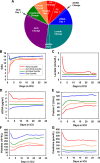Mortality Risk Profiles for Sepsis: A Novel Longitudinal and Multivariable Approach
- PMID: 32166273
- PMCID: PMC7063956
- DOI: 10.1097/CCE.0000000000000032
Mortality Risk Profiles for Sepsis: A Novel Longitudinal and Multivariable Approach
Abstract
To determine if a set of time-varying biological indicators can be used to: 1) predict the sepsis mortality risk over time and 2) generate mortality risk profiles.
Design: Prospective observational study.
Setting: Nine Canadian ICUs.
Subjects: Three-hundred fifty-six septic patients.
Interventions: None.
Measurements and main results: Clinical data and plasma levels of biomarkers were collected longitudinally. We used a complementary log-log model to account for the daily mortality risk of each patient until death in ICU/hospital, discharge, or 28 days after admission. The model, which is a versatile version of the Cox model for gaining longitudinal insights, created a composite indicator (the daily hazard of dying) from the "day 1" and "change" variables of six time-varying biological indicators (cell-free DNA, protein C, platelet count, creatinine, Glasgow Coma Scale score, and lactate) and a set of contextual variables (age, presence of chronic lung disease or previous brain injury, and duration of stay), achieving a high predictive power (conventional area under the curve, 0.90; 95% CI, 0.86-0.94). Including change variables avoided misleading inferences about the effects of day 1 variables, signifying the importance of the longitudinal approach. We then generated mortality risk profiles that highlight the relative contributions among the time-varying biological indicators to overall mortality risk. The tool was validated in 28 nonseptic patients from the same ICUs who became septic later and was subject to 10-fold cross-validation, achieving similarly high area under the curve.
Conclusions: Using a novel version of the Cox model, we created a prognostic tool for septic patients that yields not only a predicted probability of dying but also a mortality risk profile that reveals how six time-varying biological indicators differentially and longitudinally account for the patient's overall daily mortality risk.
Keywords: biomarkers; longitudinal analysis; mortality; mortality risk profiles; sepsis.
Copyright © 2019 The Authors. Published by Wolters Kluwer Health, Inc. on behalf of the Society of Critical Care Medicine.
Conflict of interest statement
Drs. Liaw, Dwivedi, and Medeiros received support for article research from the Canadian Institutes of Health Research (CIHR). Drs. Liaw and Medeiros disclosed government work. Dr. Fox-Robichaud’s institution received funding from CIHR, CIHR/Natural Sciences and Engineering Research Council of Canada, and Hamilton Academic Hospital Fund. Dr. Dodek’s institution received funding from McMaster University. Dr. Winston received grant support from the Alberta Lung Association and the Canadian Intensive Care Foundation. Dr. Lellouche received compensation for patient inclusions in the study, and he disclosed he is a co-founder, administrator, and consultant of Oxynov, R&D company. Dr. Marshall received patient recruitment fees per CIHR grant, and he received funding from Data Monitoring Committee, Asahi Kasei Pharmaceuticals and Baxter. The remaining authors have disclosed that they do not have any potential conflicts of interest.
Figures



Similar articles
-
Glasgow Coma Scale score in the evaluation of outcome in the intensive care unit: findings from the Acute Physiology and Chronic Health Evaluation III study.Crit Care Med. 1993 Oct;21(10):1459-65. doi: 10.1097/00003246-199310000-00012. Crit Care Med. 1993. PMID: 8403953
-
Acute physiology and chronic health evaluation (APACHE II) and Glasgow coma scores as predictors of outcome from intensive care after cardiac arrest.Crit Care Med. 1991 Dec;19(12):1465-73. doi: 10.1097/00003246-199112000-00005. Crit Care Med. 1991. PMID: 1959364 Clinical Trial.
-
Sepsis Care Pathway 2019.Qatar Med J. 2019 Nov 7;2019(2):4. doi: 10.5339/qmj.2019.qccc.4. eCollection 2019. Qatar Med J. 2019. PMID: 31763206 Free PMC article.
-
Survival and functional outcome of children requiring endotracheal intubation during therapy for severe traumatic brain injury.Crit Care Med. 1997 Aug;25(8):1396-401. doi: 10.1097/00003246-199708000-00030. Crit Care Med. 1997. PMID: 9267956
-
[A new score system for prediction of death in patients with severe trauma: the value of death warning score].Zhonghua Wei Zhong Bing Ji Jiu Yi Xue. 2015 Nov;27(11):890-4. Zhonghua Wei Zhong Bing Ji Jiu Yi Xue. 2015. PMID: 27132455 Chinese.
Cited by
-
Prognostic Value of Nucleated RBCs for Patients With Suspected Sepsis in the Emergency Department: A Single-Center Prospective Cohort Study.Crit Care Explor. 2021 Jul 16;3(7):e0490. doi: 10.1097/CCE.0000000000000490. eCollection 2021 Jul. Crit Care Explor. 2021. PMID: 34291222 Free PMC article.
-
Characterization of ADAMTS13 and von Willebrand factor levels in septic and non-septic ICU patients.PLoS One. 2021 Feb 19;16(2):e0247017. doi: 10.1371/journal.pone.0247017. eCollection 2021. PLoS One. 2021. PMID: 33606732 Free PMC article.
-
Immunothrombosis Biomarkers for Distinguishing Coronavirus Disease 2019 Patients From Noncoronavirus Disease Septic Patients With Pneumonia and for Predicting ICU Mortality.Crit Care Explor. 2021 Dec 2;3(12):e0588. doi: 10.1097/CCE.0000000000000588. eCollection 2021 Dec. Crit Care Explor. 2021. PMID: 34984340 Free PMC article.
-
Protein C in adult patients with sepsis: from pathophysiology to monitoring and supplementation.J Anesth Analg Crit Care. 2025 Apr 14;5(1):21. doi: 10.1186/s44158-025-00243-0. J Anesth Analg Crit Care. 2025. PMID: 40229903 Free PMC article. Review.
-
Continuous monitoring of physiological data using the patient vital status fusion score in septic critical care patients.Sci Rep. 2024 Mar 26;14(1):7198. doi: 10.1038/s41598-024-57712-9. Sci Rep. 2024. PMID: 38531955 Free PMC article.
References
-
- Vincent JL, Marshall JC, Namendys-Silva SA, et al. ; ICON investigators Assessment of the worldwide burden of critical illness: The Intensive Care Over Nations (ICON) audit. Lancet Respir Med 20142380–386 - PubMed
-
- Fleischmann C, Scherag A, Adhikari NK, et al. ; International Forum of Acute Care Trialists Assessment of global incidence and mortality of hospital-treated sepsis. Current estimates and limitations. Am J Respir Crit Care Med 2016193259–272 - PubMed
-
- Torio CM, Andrews RM. National Inpatient Hospital Costs: The Most Expensive Conditions by Payer, 2011: Statistical Brief #160 2006Rockville, MD: Agency for Healthcare Research and Quality - PubMed
LinkOut - more resources
Full Text Sources

